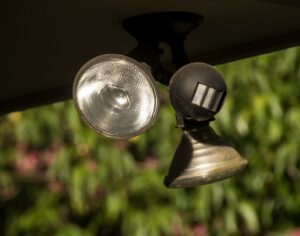PIR, Microwave & Photocell Sensors- What’s The Difference & Which Do I Need?
Posted by Emma Reid on 16th Nov 2021

Outdoor lights are a fantastic way to ensure your home is more secure, especially when combined with a sensor. We’re taking a look at three common kinds of sensor used by outdoor lights and deciding which would be the best for your home!
PIR Sensors
People and animals all produce heat, and PIR sensors use infrared radiation to detect it. When a difference in temperature is detected by the sensor, the light will switch on, switching off again when things normalise.
Because they only detect heat, as opposed to other kinds of motion, there’s a much lower chance of a PIR sensor detecting things it shouldn’t, giving you extra peace of mind that your home is secure. This makes them excellent security lights!
One big disadvantage of PIR Sensors is that they’re a lot more sensitive to changing outdoor temperatures, triggering more than they should when it’s very cold out, and less than they should when its hot. Providing a PIR sensor light with extra shelter is one way to overcome this.
The Infinity 3.0 30W PIR Motion Sensor LED Floodlight is a great option as a domestic security floodlight. Or take a look at the huge range of stylish PIR sensor activated wall lights for your perusal, so you can ensure your light matches your home’s aesthetic.
Microwave Sensors
Instead of detecting heat signatures, a microwave sensor sends out invisible microwaves throughout their detection wave, and measures how long it takes these waves to return to the sensor. This is a process known as Echo Time.
If a person or object passes through the waves, the waves will take longer to return, lengthening the echo time and triggering the light to switch on. This makes microwave sensors able to cover a wide area easily. Microwave sensors can be more efficient for indoor lighting, this is because Microwave sensors are incredibly sensitive to movement, even being able to sense motion through thin walls, glass and plastic. If you’re using a microwave sensor as a security light, there’s a higher chance of false alarms. Don’t use them facing conservatories, as the thin glass will ensure your light picks up a lot of movement when you don’t want them to!
For an example of some indoor microwave sensors, take a look at the range here.
Photocell
A photocell sensor is a very different kind of sensor. Instead of detecting motion or heat signatures, it will instead measure ambient lighting levels, switching on at dusk and switching off again at dawn.
This gives a dusk/dawn photocell light a much-needed convenience factor, that ensures you won’t have to stress about whether or not you’ve left your lights on. Combining a photocell sensor with one of the two more traditional motion sensors is a great option for anyone looking to save money without compromising on home security.
For examples of Dusk/Dawn photocells in action, take a look at the Neosteel Stainless Steel Dusk/Dawn Up/Down Wall Light GU10 IP44, which is a very stylish and modern wall light. For something which will run a lot brighter and serve well as an extra security light, there’s the Comet LED Photocell Sensor Floodlight IP65 100-300W, Daylight (4000K).
Which Should I Use?
All three sensors have advantages and disadvantages, with whichever one you need being unique to your situation. The best lighting solutions are often made by using a combination of all three.
PIR Sensors tend to be a little cheaper, so they’re a great option if you’re shopping on a budget. They are best used as security lights over doorways, in porches and in walkways.
Microwave sensors are much less sensitive to changing weather conditions, but they’re often a little pricier. They also tend to be a lot plainer in design. They’re best used in large open spaces, as garden lights and above driveways.
Photocell sensors make for fantastic ambient lighting, since you won’t need to worry about switching them on and off. Combine these with a motion sensor of your choice and you’ll be able to have general ambient lighting as well as stronger illumination when you need it most.
If you want any more information, or need a helping hand with your order, feel free to get in touch with our friendly team. We can be contacted over the phone on 0116 321 4120, or you can send us an email to cs@wled.co.uk.
For everything else, give us a like on Facebook, and a follow on Twitter and Instagram! You can also subscribe to our YouTube channel, which is full of all kinds of useful information.





